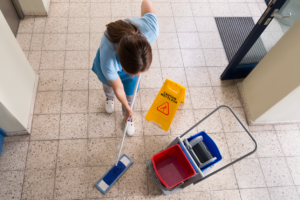March 10, 2023
Expert tips and best practices to make your safety committee thrive
Your safety committee can be a powerful tool for injury prevention.
A group of dedicated employees from throughout your company focused on making your workplace safer can make a real difference.
Whether you have a safety committee already or are thinking of starting one, you can use these best practices and activity ideas as a guide.
How an empowered safety committee prevents injuries
For one SFM policyholder, a proactive safety committee member helped prevent what could have been a serious injury.
This committee had created safety checklists in partnership with workers in different areas of the business. They walked through the checklists before each committee meeting.
On one walk-through, a safety committee member discovered a frayed cord on a welder. The employee immediately reported the defect and had the machine taken offline until it could be fixed. He didn’t wait until the meeting to report the issue, since a frayed cord could cause electrocution. The committee member was proactive and empowered to address safety concerns on the spot.
Safety committees are most effective when they can identify issues and have the power and resources to solve them. When a safety committee is working as it should, employees and managers work together to address safety concerns before they cause injuries.
Benefits of a safety committee
You may be required by state law to have a safety committee, but even if you’re not, it’s worth considering.
In Minnesota and Iowa, companies with more than 25 employees are required to have a safety committee that meets regularly. Some companies with fewer than 25 employees may also need a committee, depending on their safety record and industry. States under federal OSHA do not have a safety committee requirement. (If you’re not sure whether you need a safety committee, check with your regional OSHA office.)
Even if you’re not required to have a safety committee, it can help you:
- Give employees an avenue to bring up safety concerns
- Identify and correct hazards before they cause an injury
- Involve management and employees in making safety part of your company culture
- Educate employees about risks
- Boost morale when employees feel heard and see their concerns addressed
- Reduce the risk of OSHA citations or other state penalties
And of course, if the committee’s work can prevent even one worker injury, it’s time well spent.
Nine safety committee best practices
Even if your state doesn’t require it, having a committee with the goal of preventing injuries and accidents is worth the time and resources. To make your team the most effective it can be, follow these best practices:
1. Define the role and responsibilities of your committee
Develop a written mission statement. Clearly define the duties and responsibilities of the members. Identify and prioritize goals, and establish action plans to achieve each goal.
2. Conduct regularly scheduled meetings
Use the time to discuss accident prevention methods, safety promotion, hazards noted on inspections and other pertinent topics. Review incidents that resulted in injury as well as the “near misses” that didn’t.
3. Review accident investigation forms
Digging deep into the circumstances of accidents will help you prevent them in the future. SFM offers a downloadable accident analysis form . Have all of the supervisors use the same form to make it easier for the safety committee to review them.
4. Look for claim trends
Analyze patterns in your workers’ compensation claims. Consider three data points to start: body part, cause of injury and result of injury. Look for patterns by comparing with other data, like occupation and business location.
If you start by using a report of claim activity from your workers’ compensation insurer, you might want to consider expanding and tailoring your report to include internal information, such as department, shift and supervisor — whatever you think might help narrow the hunt on when, where and why certain injuries occur.
5. Conduct inspections
It's worthwhile to develop a safety review and inspection process – like the walk-through checklist in the example above – to identify operational hazards and observe employee work methods. Periodic inspections allow you to gauge the effectiveness of your efforts.
During a safety review you should look for: workplace environmental hazards, workstation set-up, work activity, modified work tasks and employees’ awareness of conditions.
6. Eliminate hazards. Correct employees’ unsafe behaviors.
To be effective, your inspections need follow-through. Unsafe conditions must be eliminated. Unsafe behaviors need to be corrected. Document your inspections, including appropriate follow-up procedures. Determine whether past recommendations have been addressed and implemented.
7. Promote safety
Keeping safety in front of the employees will remind them of the importance and will increase their awareness of hazards. Several types of safety promotions can work in any type of organization. See below for a list of fun safety activities your committee can organize.
8. Take action
Following up and taking action are key. If someone is injured or nearly injured, take corrective action to prevent similar accidents from occurring again. Follow up to ensure these corrections are made quickly. This might require increased safety training, additional equipment or safer work methods.
9. Recommend safety training
The purpose of training is to influence employees’ behaviors. Safety orientation should be provided to all workers, especially new employees. It ensures that they are familiar with the hazards of the workplace and know how to complete their job duties safely.
It’s a good idea to provide training regularly for workers of all experience levels and to have a training calendar to support those efforts.

Safety committee responsibilities
Once your safety committee is established, you’ll want to define its scope and responsibilities.
It’s important for all safety committees to define a purpose beyond just complying with OSHA requirements. Identifying objectives gives the group a sense of purpose and provides a roadmap for accomplishing something significant.
To get committee members to engage, start by creating a roles and responsibility sheet. Let committee members choose which tasks they want to take on and write them down. This could include items like planning a safety talk or taking meeting notes.
You may decide to make your committee responsible for some or all of the following:
- Reviewing your safety policies and practices
- Doing regular safety walk-throughs of your facility and noting any concerns
- Encouraging employees to report safety hazards to your group
- Looking at past incidents and “near misses” for patterns and areas to focus on
- Looking ahead to potential issues that could happen in the near-term
The committee provides a venue for front-line employees and managers to work together. It engages people at all levels of the organization and helps to build a culture of safety.
Fun safety committee activity ideas
Are you looking for ideas to inspire your employees or to re-invigorate your safety committee?
Successful safety committees stay interesting, fresh and visible. They get outside of their comfort zones and get creative.
Popular activities that work for almost any type of business include safety contests, posters, special safety/health events, guest speakers and training programs, employee suggestion programs and safety recognition awards.
Get the committee out of the conference room and out into your facility with these ideas for hands-on activities:
- Schedule a series of Supervisor Initiated Trainings (SITs) on relevant topics
- Record a video about a safety issue
- Hang up safety posters from SFM around the facility
- Create an award for employees who are “caught” practicing safety
- Bring in an ergonomics specialist to evaluate workstation set-up
- If your organization holds a benefits fair, have a booth for your safety committee
- Involve committee members in choosing personal protective equipment
- Hold committee meetings outside during nice weather, or take a field trip for a team-building event
Other ideas include:
- Write safety tips for your company newsletter or intranet
- Create a schedule of supervisor-presented toolbox talks that include opportunities for feedback from employees (such as SFM's Supervisor Initiated Trainings (SITs) series).
- Facilitate a find it/fix it incentive program to encourage employees to report safety hazards and see that they are corrected.
- Plan an informational campaign — with email messages, posters, maybe even a contest — around a key safety topic like winter slips and falls.
- Create a display and promotional board about a safety topic, such as using traction footwear to prevent slips and falls.
- Implement a "virtual safety store" (a page on your intranet with links to recommended vendors) where employees can learn about recommended home safety products such as carbon monoxide detectors and fire extinguishers.
- Issue awards or plaques to recognize employees who point out safety hazards, for example, a plaque on a machine that states, "This machine made safer by Sarah Smith."
- Have fun at meetings by incorporating quizzes, team-building exercises, compelling videos, etc.
- Encourage safety committee members to bring a guest to each meeting, who can be an employee at any level of the company. This helps increase safety awareness and sustainability of the committee.
When your safety committee is engaged and empowered, it can serve as a vital piece of your loss prevention program. With enthusiastic members and creative activities, the committee can spread a culture of safety to every employee.
Additional resources on safety committees:
- Safety Committee Success Guide
- Safety Committee Template Packet (Word document)
- Safety committees 5-Minute Solution
- Safety committees CompTalk
This is not intended to serve as legal advice for individual fact-specific legal cases or as a legal basis for your employment practices.
Want more content like this?
Get the latest Simply Work Comp blog posts in your inbox.





